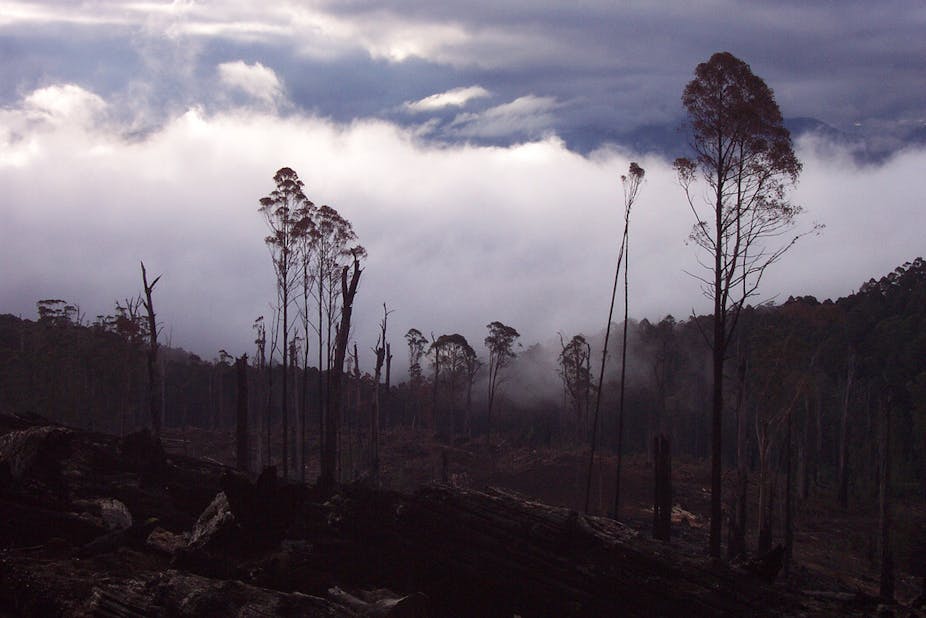We are poised at a pivotal moment for native forests, the wood products industry and climate change. Australia is moving away from a damaging native forestry industry - and a damaging conflict over its future - to a plantation industry with broad-based support. Rob Oakeshott’s push this week to promote burning native-forest wood for electricity production could kick off more logging, and more conflict.
Rob Oakeshott and Tony Windsor, together with all other members of the Multi-Party Climate Change Committee, agreed in July 2011 to exclude native forest wood from being subsidised as a renewable energy resource. This decision put in place a crucial backstop to see the end of Australia’s forest wars. But now Oakeshott has changed his position.
The Multi-Party Climate Change Committee, chaired by PM Gillard and including the Greens and Independents Tony Windsor and Rob Oakeshott, agreed to amend the Renewable Energy Target regulations. Native forest biomass would no longer be regarded as “renewable” when burnt to generate electricity.
Forestry policy making has rarely been so thorough: the exclusion included products, by-products, and waste associated with or produced from, clearing or harvesting of native forests, subject to appropriate transitional arrangements for existing accredited power stations. The Committee’s decision was an environmentally sensible policy correction for a forestry industry that is exiting native forest wood resourcing.

The removal meant that native forest electricity producers could still produce electricity but they would not receive Renewable Energy Certificates (RECs). The government created the RECs market to achieve its Renewable Energy Target: wholesale electricity retailers and some generators must source at least 20% of their electricity from renewable sources backed by RECs.
For native-forest-based energy projects, the RECs could constitute up to 50% of the project’s income.
Having signed the multi-party agreement in July, in late October 2011 Rob Oakeshott had second thoughts. With the exposure draft of the Renewable Energy Target regulations in hand and what appears to be some local business lobbying, Oakeshott asked “local residents to have their say on new rules which ban the use of native forest waste as an accredited RET energy source.”
A month later, Oakeshott appears to have turned from seeking comments to becoming a native forestry lobbyist. He said that “[b]usinesses with potential investment projects using wood waste for biomass energy should use this time [before moving his disallowance motion] to make detailed representations to the federal government and MPs who represent electorates with viable commercial forestry contracts and processing mills.”
Oakeshott’s hope from this lobbying was that “all MPs seek best policy”. From his statement, “best policy” refers to the local abattoir wanting to use some local sawmill offcuts for power. There is nothing in the regulations stopping the abattoir from using the offcuts for power. What the regulations aim to do is prevent the revenue from the RECs market opening a new and very large market for native forest wood around Australia.

This is not a local or peripheral issue. It is nationally important. On Friday 10 February, Oakeshott wrote to Members of Parliament explaining his move to disallow the regulations. He stated that with all aspects of the Agreement having been introduced, he has honoured the Multi-Party Climate Change Committee Agreement and is now free to vote against the agreement as expressed in a bill or regulation.
Oakeshott’s letter conveys no understanding of the Australian forestry industry situation and outlook. He states that sawn timber and paper (including woodchip exports) drives native forest logging, with energy being a sensible use of “waste”.
Missing from his account is Australia’s plantation competition: sawn timber stopped driving Australia’s native forest logging in the 1980s and woodchip exports are no longer driving native forest logging. And so evaporates the “waste”. Opening native forest wood to the energy market will turn the economically and environmentally desirable trend decline in native forest logging into increasing logging levels.
Australia’s plantation industry is about to completely displace native forest wood from the major commodity markets of sawn timber, paper and woodchip exports. Today, between 85 and 90% of Australia’s production of sawn timber and wood panels is plantation based.
As the native forest sector lost these markets to the softwood plantation competition, it became more dependent on export markets for woodchips. Now, Australia’s hardwood plantations are displacing, with ferocious speed, native forest chip exports (see figure above). In the very near future we can expect very little commodity-based logging of Australia’s native forests, as long as governments resist engineering new commercial opportunities for native forest wood.
As members of the House of Representatives decide whether to support Oakeshott’s disallowance motion they should reflect on 40 years of conflict over native forest woodchipping. If native forests are opened to burning for “renewable energy”, Australia’s forest wars will rage for many more decades.

